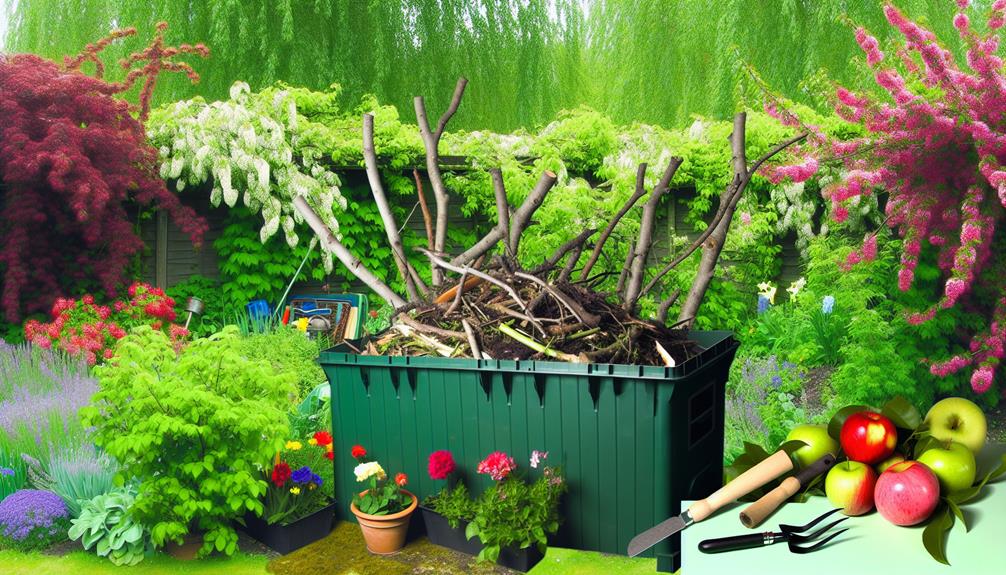

You can definitely compost branches, and doing so enriches your soil with essential nutrients while reducing yard waste. However, since branches decompose slowly, it’s best to chop them into smaller pieces using pruning shears or an electric shredder. This helps them break down faster. Balance your compost pile with green materials for nitrogen and brown materials, like branches, for carbon.
Maintaining your pile moist and turning it regularly guarantees efficient decomposition. Softwood branches break down quicker than hardwood, so consider the type too. To make your composting journey successful and discover more effective tips, let’s explore further!
By composting branches, you can enrich your soil with essential nutrients while reducing yard waste. This practice transforms what might seem like useless debris into valuable organic matter for your garden.
As branches decompose, they break down into smaller particles, creating a rich, dark compost. This compost enhances soil structure, improves moisture retention, and provides crucial nutrients for plants.
By participating in this process, you’re contributing to a sustainable cycle, turning waste into growth. You’ll notice healthier plants, stronger root systems, and vibrant growth.
Plus, composting fosters a sense of community and environmental stewardship. By embracing composting, you’re joining a growing movement of eco-conscious individuals committed to making a positive impact on our planet.
Composting branches often presents challenges due to their dense and fibrous nature. You might notice that branches take longer to decompose compared to softer plant materials. Their tough, woody structure resists breaking down quickly, which can delay the composting process. To help you understand better.
Here’s a quick comparison:
| Material Type | Decomposition Time | Ease of Composting |
|---|---|---|
| Soft plant matter | Few weeks | Easy |
| Small twigs | Few months | Moderate |
| Large branches | Several years | Difficult |
These differences can make you feel like you’re not progressing as fast as you’d like. But don’t worry! By breaking branches into smaller pieces, you can speed up the process and achieve the rich compost you desire.
When composting, it’s crucial to grasp the distinctions between hardwood and softwood branches, as each type impacts your compost in unique ways.
You’ll also need to take into account the ideal branch size for faster decomposition, since larger branches take longer to break down.
Keep in mind, factors like moisture, temperature, and branch type all play a role in how quickly your compost pile will transform into rich, usable soil.
Understanding the differences between hardwood and softwood branches can help you decide which types are best for composting. Hardwood branches, from trees like oak and maple, are denser and take longer to break down. This slow decomposition process can enrich your compost over time, adding valuable nutrients.
On the other hand, softwood branches, from trees like pine and spruce, decompose more quickly. They’re great for adding structure to your compost pile, helping with aeration and moisture control.
Selecting the proper branch size guarantees that your compost breaks down efficiently and delivers the best results. Aim for branches that are small and manageable. Large branches take longer to break down, slowing your composting process. For an ideal compost pile, you should stick to branches that are no thicker than your thumb.
Here’s a quick guide to help you:
| Branch Size | Composting Suitability |
|---|---|
| < 1/4 inch | Ideal |
| 1/4 – 1/2 inch | Good |
| 1/2 – 1 inch | Usable but slower |
| 1 – 2 inches | Needs chopping or shredding |
| > 2 inches | Not recommended |
Different types of branches decompose at varying rates, directly affecting your overall composting efficiency. Hardwood branches, like oak or maple, break down slowly due to their dense structure, taking years to fully decompose.
Softer woods, such as pine or willow, decay much faster, often within a few months, making them excellent for quicker composting cycles.
Fresh, green branches tend to decompose faster than older, dried-out ones because they contain more moisture and nutrients.
To speed up the process, cut branches into smaller pieces, increasing their surface area and allowing microbes to work more efficiently.
Also Read: Can You Compost Asparagus?
To get branches ready for composting, you’ll need to chop them into smaller pieces to expedite the decomposition process. By breaking branches down, you create more surface area for microbes to work on, making them break down faster.
Use a sturdy pair of pruning shears to cut branches into manageable lengths, ideally around 1-2 inches. This not only helps decomposition but also guarantees your compost heap remains aerated and well-balanced.
Remember, smaller pieces blend better with other compost materials, creating a uniform mix. As you prepare your branches, think of it as a communal effort towards a greener, more sustainable environment.
Your careful preparation is a step toward a thriving compost pile and a healthier planet.
When it comes to shredding branches for composting, you’ve got a few options that can make the job much easier.

Manual shredding techniques, like using pruning shears or a handsaw, are great for smaller branches.
For a more efficient approach, electric shredders can handle larger quantities quickly, saving you time and effort.
Handheld pruning shears and loppers are essential tools for manually shredding branches into manageable pieces for composting. You can use pruning shears for smaller branches, up to about half an inch thick. They’re perfect for snipping twigs and thin branches, making them easy to mix into your compost pile.
For thicker branches, loppers are your go-to tool. They’ve long handles, giving you extra leverage to cut through branches up to two inches thick. By manually shredding branches with these tools, you’ll create more surface area, helping them decompose faster in your compost.
Plus, using these tools connects you more deeply with the composting process, making you feel part of a community dedicated to sustainable gardening.
Electric shredders offer an efficient and time-saving solution for breaking down branches into compostable material. They’re perfect for transforming garden waste into valuable compost. These machines are user-friendly and powerful, making yard work less of a chore and more of a community activity.
Imagine teaming up with family or friends, each taking turns feeding branches into the shredder, and watching as the pile of compostable material grows. Electric shredders come in various sizes, so you can find the perfect fit for your garden needs. Plus, they minimize the physical effort required, compared to manual shredding.
To achieve ideal decomposition, you need to balance green and brown materials in your compost pile. Green materials are rich in nitrogen and include things like fruit scraps and grass clippings. Brown materials, like dried leaves and branches, are high in carbon. A balanced mix guarantees that microorganisms can break down the compost effectively, creating nutrient-rich soil for your garden.
Here are some examples of green and brown materials:
Also Read: Can You Compost Almond Shell?
To keep your compost pile thriving, it’s essential to maintain proper moisture levels, ensuring it’s as damp as a wrung-out sponge.
You’ll need to water your pile regularly, but also employ moisture retention tips like adding straw or leaves to help balance hydration.
Be on the lookout for signs of overwatering, such as a soggy texture or unpleasant odors, and adjust accordingly to maintain the perfect environment for decomposition.
Maintaining the right moisture levels in your compost pile is essential for efficient decomposition. You’ll need to water your compost regularly to keep it damp but not soggy. Aim for a consistency similar to a wrung-out sponge. Over-watering can lead to a smelly, anaerobic pile, while under-watering slows down decomposition.
Here’s how to get it right:
Maintaining your compost at the correct moisture level is crucial for speeding up decomposition and preventing unpleasant odors. You’ll want to strike a balance; think of your compost like a wrung-out sponge—damp but not soggy. Add water gradually, observing how well it absorbs. If it’s too dry, decomposition slows; if it’s too wet, it can get smelly and attract pests.
Mixing in materials like shredded leaves or straw helps maintain this perfect moisture balance. These elements absorb excess water and distribute moisture evenly.
Also, turn your compost regularly to promote aeration and even moisture levels. Remember, you’re creating a mini-ecosystem, so nurturing it with the right moisture keeps everything thriving together.
Overwatering your compost can lead to a host of issues, including a foul smell and slower decomposition. You’ll want to keep an eye out for signs that your compost is too wet. Here are some key indicators:
Also Read: Can You Compost Batteries?
Turning and aerating the compost pile regularly guarantees it decomposes efficiently and prevents unpleasant odors. When you turn the pile, you introduce oxygen, which is vital for the microbes breaking down your branches and other organic materials. Aim to turn your pile every couple of weeks; this helps to evenly distribute moisture and heat, accelerating the decomposition process.
You don’t need any fancy tools—just a garden fork or shovel will do the trick. By staying consistent with this practice, you’ll notice your compost breaking down more uniformly, fostering a sense of accomplishment and community with fellow composters. Remember, a well-aerated pile not only works faster but also smells fresher, making your composting experience much more pleasant.
To speed up decomposition, regularly add small, manageable pieces of branches and other organic matter to the compost pile. This not only accelerates the breakdown process but also creates a sense of community as we nurture our environment together.

Here are some tips to help you:
Once your compost has fully decomposed, it’s time to put this nutrient-rich material to good use in your garden. Spread it evenly over your garden beds to enrich the soil, helping your plants grow strong and healthy.
Mixing finished compost into the top few inches of soil improves its structure, water retention, and nutrient content. You can also use it as a top dressing for your lawn, giving grass a natural boost.
Compost tea is another great use—steep compost in water to create a liquid fertilizer. By using your compost, you’re not just feeding your plants; you’re building a sustainable and thriving garden community.
Join the cycle of renewal and watch your garden flourish!
Begin composting branches is a fantastic way to enrich your garden soil, reduce waste, and support the environment.
By shredding and properly preparing the branches, you guarantee they break down efficiently.
Remember to maintain the right moisture levels and regularly turn the pile for better aeration.
With patience and care, you’ll soon have nutrient-rich compost ready to nourish your plants.
Engage in this eco-friendly practice, and watch your garden thrive like never before!
